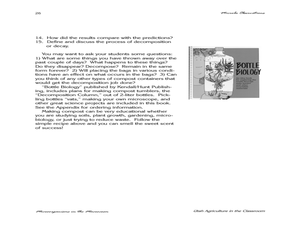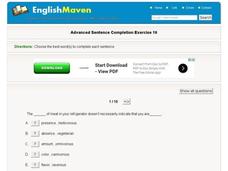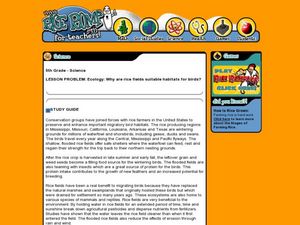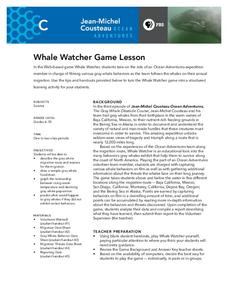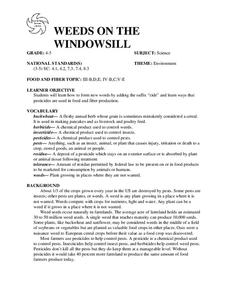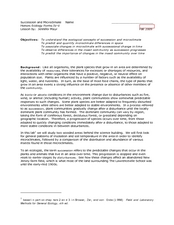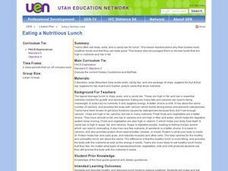Curated OER
Scales, Scutes, and Skins
Students identify the various adaptations of reptiles and amphibians. After distinguishing between reptiles and amphibians, students discuss the ways in which their adaptations aid in their survival. They participate in a hands on...
Curated OER
Hold on Tight!
Students explore the close connection between plant roots and the soil in which they grow. They investigate the roots of plants, make models of plant roots using pipe cleaners, and examine photos and images to explore the connection...
Curated OER
4-H Horticulture/Garden Activity Page- Beginning
For this 4-H garden project worksheet set, student study the parts of seeds and plants. They make a mini-greenhouse. They complete a career scavenger hunt, tools word search, and experiment to learn more about the effect of water on seed...
Curated OER
Pollination
Fourth graders explore the pollination process. In this plant biology lesson, 4th graders dissect a flower to identify the parts of a flower and watch a video to see seed dispersal. Students write about the pollination process.
Curated OER
Feathers for Lunch Lesson Plan
Students discover different types of birds and the habitats in which the dwell. In this bird lesson, students read Feathers for Lunch, discuss bird facts, and build a bird habitat.
Curated OER
Discovery Science Center Activities
Fourth graders complete a variety of experiments to meet science goals. In this life sciences lesson plan, 4th graders make yogurt, discover the attraction of opposite charges in electricity, learn the effects of glaciers, and...
Curated OER
Rotten Truth
Students complete activities to study decomposition. In this decomposition lesson, students work in pairs to observe a decay buffet experiment. Students keep compost bag journals. Students define and discuss the process of decomposition.
Curated OER
Advanced Sentence Completion: 16
In this sentence completion activity, students complete sentences by filling in the blanks for 2 words in each sentence. Students complete 10 sentences.
Curated OER
Ecology: Why Are Rice Fields Suitable Habitats for Birds?
Fifth graders discover the uses for rice by reading about the habitats of certain birds. In this agriculture lesson, 5th graders research birds from the Gulf Coast and California and their reasons for living in rice fields....
Curated OER
Immersion Presents Monterey Bay
Students study Monterey Bay. In this Monterey Bay instructional activity, students create a model of upwelling around Monterey Bay. Students simulate surface water movement relative to prevailing winds.
Curated OER
What Do We Use From the Rainforest?
Students identify items we use from the rainforest. In this earth science instructional activity, students recall prior facts about the rainforest and list items we use from the rainforest. Students create "Rainforest Cookies" using...
Curated OER
Whale Watcher Game Lesson
Students study the gray whale migration and compare their populations to the increasing ocean temperature. In this whale watcher lesson students draw a food chain.
Curated OER
Let's Sort a Salad
Learners examine edible plants by identifying salad ingredients. In this botany lesson, students discuss the different vegetables that can be eaten in a salad and draw them on a worksheet. Learners review vegetable vocabulary and examine...
Curated OER
Rate Your Plate
Third graders analyze the nutrients, calories, and food groups using the USDA CNPP website Interactive Healthy Eating Index. They write a summary of their personal findings related to their eating habits - including some ways to improve...
Curated OER
Milk: A Practical Application
Students examine the impact of the physical and chemical properties of milk and its use as an important food.
Curated OER
What Can I Do?
Pupils identify ways to handle conflict. In this conflict resolution lesson, students brainstorm times when they had a conflict with a friend. Pupils develop a strategy to deal with conflicts in the future, such as talking it through or...
Curated OER
Plants Word Search Puzzle
In this science learning exercise, students look for the words that are related to the concept that is reviewed in the sheet. They also acquire new vocabulary.
Curated OER
CALORIE COUNTDOWN
Students will categorize foods according to their components and energy content.1. Design a large bulletin board with sections for carbohydrates, fats and proteins.
2. Ask students to bring labels and packages of different food products....
Curated OER
WEEDS ON THE WINDOWSILL
Discuss the suffix "cide." Have young scholars name words having this suffix (homicide, suicide, genocide). Ask students what all these words have in common. Then ask young scholars to define the word "pesticide." (Pesticides control...
Curated OER
Succession and Microclimate
Learners compare the population of insects in different microclimates. In this biology lesson, students collect data using probes to tabulate temperature and soil data. They predict how certain parameters change as an area goes...
Curated OER
Testing for Life’s Molecules
Want to hear a joke about sodium? Na. Young scientists test various materials to identify if they include protein, starch, and glucose by using the Biuret test, iodine starch test, and Benedict's test respectively. After practicing with...
Curated OER
Eating a Nutritious Lunch
Students identify the types of foods and snacks they eat for their lunch. In groups, they identify healthy foods along with unhealthy foods. They design a new lunch menu using only healthy food and identifying which food group they belong.
Curated OER
Eating a Low-fat Nutritious Lunch
Students describe healthy and delicious lunch foods to replace junk foods. They make and eat lunch foods.
Curated OER
The Secreat to Good Health: Eating Right and Exercise
Students create a seven-day record of all the foods they consume. They analyze what type of food was the most frequent in everyone's diet. They look up each food and record its daily recommended amount.






